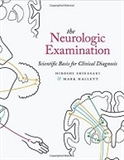Book Review: The Neurologic Examination: Scientific Basis for Clinical Diagnosis
Authors: Hiroshi Shibasaki, MD, PhD and Mark Hallett, MD
Reviewed by: Susanne A. Schneider, MD, PhD and Shilpa Chitnis, MD, PhD
Publisher: Oxford University Press (2016)
November 2016
 This new book, published by Oxford University Press (OUP) in August 2016 is based on the successful Japanese textbook written by one of the authors, Dr. Shibasaki. The authors address the book to medical students, residents, practicing neurologists and other students of neurosciences. The idea is to ensure that in spite of advances in imaging and electrophysiologic testing, the contribution of history taking and physical examination towards making diagnoses is not neglected.
This new book, published by Oxford University Press (OUP) in August 2016 is based on the successful Japanese textbook written by one of the authors, Dr. Shibasaki. The authors address the book to medical students, residents, practicing neurologists and other students of neurosciences. The idea is to ensure that in spite of advances in imaging and electrophysiologic testing, the contribution of history taking and physical examination towards making diagnoses is not neglected.
The book is organized into 31 chapters focussing on not only anatomical but also functional organization. The first three chapters introduce the reader to general priniciples governing the diagnosis of Neurological Diseases, and approach to history taking, general physical and neurological examination. This is followed by 20 chapters dedicated to the neurological examination of functions and its various findings and how to interpret them.
Some examples include the evaluation of consciousness, tendon reflexes and pathologic reflexes and posture and gait. The following five chapters (24-28) are dedicated to disorders which share the same anatomical basis (e.g. thalamus) or pathophysiology (e.g. ion channel disorders). Finally, the book ends with more general thoughts about neurological emergencies; disability, functional recovery, and prognosis and "how to plan laboratory tests." The book is completed by a preface, explanatory notes and an afterword ("For Those Who Wish to Study Neurology").
The layout is appealing as it contains both "main text" and additional approximately 100 discussion text boxes with further information providing a more in-depth look at particular topics without interrupting the reading flow of the text. Images demonstrate characteristic features of the neurological findings (e.g. skin changes in neurological disorders), brain imaging, and electrophysiological recordings). The reader is reminded of the Japanese spirit of the book when presented with micrographia from a Japanese patient and a comparative Japan coma scale on the lines of the Glasgow coma scale. Tables provide some at a glance topics, such as differential diagnosis, (e.g. genetic forms of parkinonism), localization pointers and evaluation scales (e.g. Glassgow coma scale).
Readers that want to know more about topics approached in the book will find selected, up to date references at the end of each chapter. Over all, this is a great tribute by the authors to the distinguished mentors who trained them and were giants in the field and clearly meets the objective of providing a scientific rationale for detailed and accurate history taking and examination, which are critical for lthe ultimate localization and differential diagnosis in clinical Neurology.






